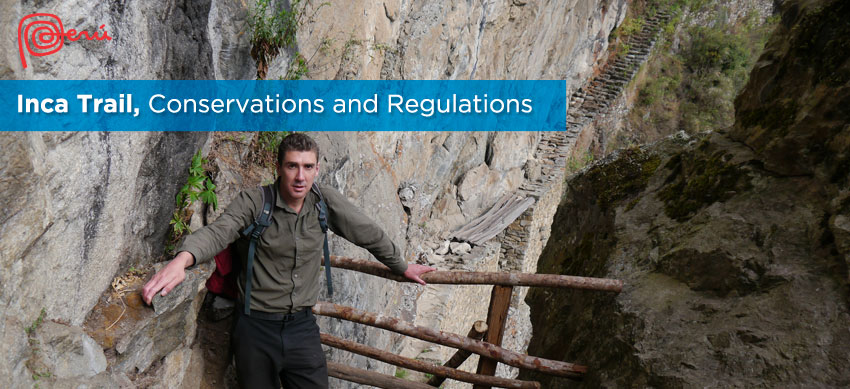
The Inca Trail is the most famous hiking route in Cusco and Peru. Every day the route is covered by 500 people (200 tourists and 300 workers including guides, porters and cooks). This number of visitors can cause damage to the environment that surrounds these historic roads. Intense tourism can also cause irreversible damage to Machu Picchu. Find out what measures are being implemented for the conservation of the Inca Trail to Machupicchu.
We consider that the tourist activity must be an agent of conservation of the tourist, natural and cultural attractions; and conserve them for the population of origin and for the tourist himself. In this sense, there must be a commitment on the part of the tourist and the tour operator, to become a help; in a management tool that collaborates with the conservation of both natural and archaeological tourist attractions and thus reduce the socio-cultural and environmental impact that occur with the constant flow of tourism.
Tourism and natural areas of Peru
Peru is the third largest country in South America with an attractive natural biodiversity. It basically has three types of landscape:
- Coast – It covers a 2,500-kilometer plain along the Pacific. It is located at sea level. It has more than 8 million inhabitants. In this region is Lima, the capital of Peru.
- Sierra – It is the area of the Andes covers 27% of the land surface begins at 3,350 m. It is the height where Cusco is located, but in this region the Andes rise up to 6,000 m. It is a zone with a climate between cold and temperate.
- Jungle – It is the third region that covers 60% of the land area of Peru and is home to less than 6% of its population. It is an area of great value and rainfall, which is why it is home to at least 10 million species of tropical flora and fauna.
Tourism on the Inca Trail
The Inca Trail is considered one of the best hiking trails on the planet. It is a 4-day hike (39 kilometers) that, after traveling the route of the qhapac ñan (royal Inca roads), ends in Machu Picchu, just as the Incas did.
This hiking trail is open every day of the year. It only closes its doors to tourism in February, the rainiest month. On those days maintenance work is carried out on the route.
On the days that the Inca Trail is open, it receives 500 people every day. Of this number 200 are tourists. The rest is made up of the support team for visitors (porters, cooks, guides and more).
In other words, in one day these roads are covered by two thousand people (four groups of 500 walkers). The final destination is Machu Picchu which, in turn, is visited every day by more than 3,000 people. Starting the Inca Trail is crossed by five life zones. The rainy season (November to March) is the best time to see these flowers. The cloud forests that surround the Inca Trail route (between 1,800 meters above sea level and 3,000 meters above sea level) are the regions where the most diverse orchids of the Historic Sanctuary of Machu Picchu flourish.
The Inca Trail is so popular among tourists that it is necessary to buy the tour 6 or 7 months in advance. Otherwise it is not possible to find availability.
Conservation of the Inca Trail
The high level of tourism can cause damage to the historic routes of the Inca Trail. The dangers encompass both Inca constructions as well as the diverse flora and fauna that make up the landscapes.
There are two entities that organize the protection measures of the route: the Ministry of Culture of Peru, in charge of the conservation of the Qhapac ñan routes as well as the Inca archaeological sites. The other public institution is the Sernanp (National Service of Natural Areas Protected by the State) that seeks to conserve the Historic Sanctuary of Machu Picchu, its flora, fauna and more.
The Ministry of Culture of Peru orders the closure of the Inca Trail every February. On those days maintenance work is carried out on the route qhapac ñan.
The Sernanp organizes cleaning work on the route of the Inca Trail and the Historic Sanctuary of Machu Picchu. It should be noted that the greatest threat on the route is forest fires caused by local farmers.
More information
Although Peru has regions of the coast, mountains and jungle, there are actually icho natural regions that cover different altitudes and geographies. The Inca Trail is located in the ‘Selva alta’ region (also called rupa rupa ). This region stands out for its cloud and humid forests where there is a great diversity of flora and fauna.
To better conserve these historic routes, visitors must take care of the environment. It is required not to throw waste on the ground. Nor do you pluck the flowers. The tour guide will give the visitor all the necessary information to better conserve these roads.
By Inca Trail Machu Picchu - Last updated, 07-12-2021
Interested in the Inca Trail? Know more about Nature!
- Fauna during the Salkantay Trek
- Cloud forest of Machu Picchu – The geography of Machu Picchu
- The closest waterfalls of Machu Picchu
- How to avoid the environmental impact on the Inca Trail?
- Coca leaf, ideal for trekking in Peru
- The Cantuta flower. Where to find it on the Inca Trail?
